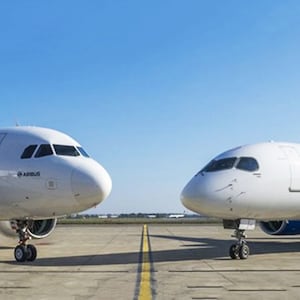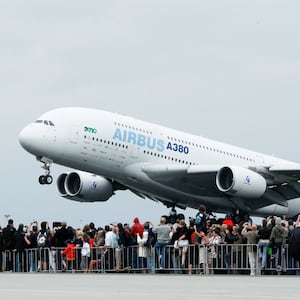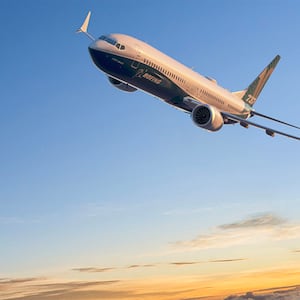The first important clue came in an email I received from a reader who lives in Boston:
“Just returned from a miserable flight from Boston to Houston on United in ‘First Class’ aboard a Boeing 737-MAX—never again, truly horrible and uncomfortable. Returned on JetBlue in coach, on an Airbus A220, much more comfortable and 75 percent less expensive. Won’t do a 737 again when I can avoid it.”
Coming at a moment when more Americans than ever are enduring that nemesis of pleasure in travel—a seat in coach—there was a lot to unpack from this one experience.
First, we’re so used to our lives being improved by generational technical upgrades that happen relatively fast, as with broadband internet and smartphones, that it’s valid to wonder why that’s not true in the rear of airplane cabins. The rest of the airplane has been transformed in several decades—cockpit automation that has made flying much safer, rapid evolution of engines that makes them far more efficient and environmentally tolerable. But coach remains basically a tube with as many seats jammed into it as possible. For many it’s going to remain that way for years to come.
Only two airplanes flying on regular domestic routes in the U.S. have cabins that were from the beginning designed to use the latest technology to enhance the comfort of flying: one is the Boeing 787 Dreamliner and the other is the above-mentioned Airbus A220. The Dreamliner, much liked by passengers, is a twin-aisle widebody used for the longest, transcontinental routes, while the smaller A220 is just becoming common enough on shorter routes to be a game changer.
Neither Boeing nor Airbus planned it that way. The A220 began its life in Canada, conceived and built by a company named Bombardier. The designers had a simple mission: build a new single-aisle jet that passengers might actually love, give it a cabin climate with notably less dry air, as well as making it very quiet, and—this was the clincher—making it wide enough for only five seats per row, split three/two, so that no airline could jam six seats into a row.
They succeeded on all counts, but as the first jets began reaching the airlines Bombardier ran out of money. That was music to the ears of Boeing, who, from the start, had correctly judged that the airplane might make serious inroads into the market for shorter-range single-aisle jets that they had dominated for decades with their 737—a jet designed in the 1960s that became a world favorite of budget airlines with the sardine-can approach to seating.
That joy was short-lived. Airbus, who ended the 737 monopoly of single-aisle jets in the 1980s with their A320, stepped up and bought the whole project from Bombardier, renaming it the A220. Boeing reacted by attempting to get tariffs imposed in the U.S. on sales of the A220 that would make it too expensive for American airlines to buy; Airbus successfully countered that by moving some of the A220 production line to Alabama (in any case many key parts of the jet, including the engines, were made in the U.S.).
But the battle between Boeing and Airbus is really a story best told in inches, because those inches are decisive for everybody taking a right turn on boarding.
When Airbus designed the A320 they decided to make the cabin seven inches wider than the 737’s. It may not seem much, but it was a tough decision to take. Its virtues were that it meant that each seat could be an inch wider, and also that the ceiling was higher, the baggage bins were larger and there was less of a claustrophobic tube effect. The downside was that it made the airplane heavier, something that Boeing immediately exploited because it meant that the jet used more fuel and was more expensive than the 737 to operate.
For airlines that put the bottom line first (as opposed to the size of bottoms), that counted. To this day, the two largest budget airlines in the world, Southwest in the U.S. and Ryanair in Europe, have bought each generation of the 737, never Airbus. Gradually, though, other airlines noted that passengers preferred the A320 for its better creature comforts. In fact, the difference in operating costs has been largely removed by increased engine efficiency and, according to Aviation Week Network that tracks all airline purchases, by 2033 the world fleet of A320s will outnumber the 737 by more than 1,500.
Two measurements are crucial to passenger comfort: the width of the seat and what is called pitch—the space between seat rows that determines leg room and ease of entry and exit. (The FAA regulations mandate that there should be at least nine inches between the front of a seat and the back of the next seat, which is hardly generous). Seat width in coach in the 737 is mostly 17 inches (on some of the latest models it can be 17.8 inches, achieved by taking space from the aisle) while in a typical budget cabin the pitch is 32 or 33 inches. On the A320 the seat width is never less than 18 inches and the pitch varies, for example on the budget carrier Frontier it can be as low as 28 inches or as high as 38 inches according to the price category.
Delta was first adopter for the A220 in the U.S. and the difference in seats was immediately clear to passengers: in coach a seat width of 18.6 inches and a pitch of 30 to 32 inches and in a small First Class section a width of 21 inches and a pitch of 36 inches. But other advances added to the impression of a completely updated experience: a wider aisle that eased boarding, larger windows, as well as a vertical, not curved sidewall and larger overhead bins.
JetBlue, which followed Delta with the A220, have similar sized seating. They have made Boston Logan a hub for their A220 flights, flying from there not just to a score of U.S. cities but also to Bermuda and Providenciales in the Turks and Caicos Islands.
JetBlue was founded in 1999 by David Neeleman, who used the A320’s larger cabin to underpin his branding of the airline as one that wanted to be loved instead of hated, with its often excessively gregarious cabin staff. He left JetBlue in 2008 to start up a new airline in Brazil, Azul, now the nation’s largest carrier. He returned to the U.S. market in 2018 to launch an airline named Breeze, with the idea of building a new domestic network aimed at under-served intercity routes and around the virtues of one new airplane—the A220.
Because of long wait times for A220s the airline also uses smaller Embraer jets on shorter routes but as new jets arrive the A220 will become dominant. Breeze exploits the A220’s space in three cabin sections: 12 premium seats, 20.5 inches wide with 39 inch pitch; 45 “extra legroom” seats with seats 18.8 inches wide and a pitch of 33 inches, and 80 standard coach seats with 18.8 inch wide seats and a pitch of 30-31 inches.
These cabin comforts are part of a virtuous cycle: with far more fuel-efficient engines the operating costs of the A220 are 14 percent lower than any other jet in its class, which is another reason why Airbus can’t deliver the airplanes fast enough to meet airline demand. At the moment, partly because of post-pandemic problems in the supply chain, Airbus delivers only four a month and, even though the goal is to produce 14 a month by the middle of the decade, it will take years to clear the backlog of orders.
Boeing’s 787 Dreamliner should get the credit for showing the way in what a 21st-century passenger should expect, with much-improved cabin climate, bigger windows and individually controlled lighting. It was the first Boeing jet in which passenger opinions about needed advances in cabin quality carried as much weight as the airlines’ specifications. But it is a twin-aisle widebody, and has therefore been vulnerable to bean-counter seating in coach: on United, seats that are only 17.3 inches wide and on American as tight as 16.2 inches wide.
As for the ubiquitous Boeing 737, the ultimate in coach hell is yet to come, with the largest of all versions, the 737MAX-10. I first reported on this prospect in The Daily Beast five years ago, pointing out that the original 1960s version of the 737 accommodated around 100 passengers while the 737MAX-10 has been stretched to take 230 coach seats, giving the highest seat density of any jet and making the cabin twice the length of the original. At maximum seating with its narrow fuselage the tunnel effect will be like nothing before.
Delivery of the 737MAX-10 has been delayed for years by a new FAA certification process imposed after the two fatal crashes of early versions of the 737-MAX. According to a report in Aviation Week the first 737MAX-10 models won’t reach airlines until early in 2025. But the really depressing thing about that is that it means they will be still flying passengers until at least 2050.










